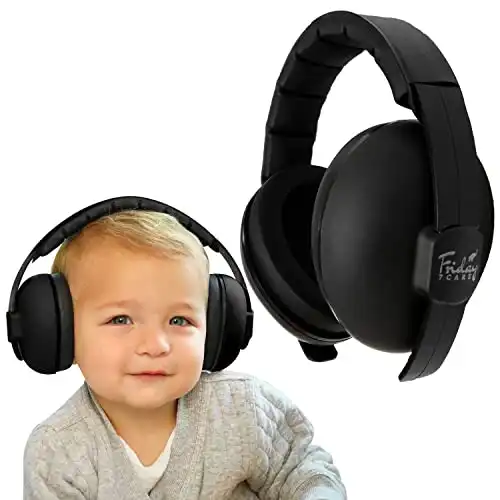Happy Ears, Happy Flight: A Parent’s Guide to Baby Ear Protection in 2023!

Do you have an upcoming trip and are wondering if your baby needs ear muffs for flying?
After not using them with my first kid and dealing with some fussy flights, I decided to give them a try on our youngest. And I’m sure glad I did, these have been a game changer.
This post may contain affiliate links. For my full disclosure policy click here.
Now both kids are rocking the ear muffs and loving them!
Keep reading to get the facts on why, when, and how to use ear muffs for your baby’s next flight as well as my favorites.
Do Babies Need Ear Muffs For Flying?
I strongly recommend using ear protection for your little one on your next flight. It might just make your flight fuss free!
We’re a big fan of the Alpine Muffy Baby ear muffs!
Keep reading to learn why I love these and some other tips and tricks for an easier flight for your baby.
Why Fly With Ear Muffs?
Noise: Air travel, especially during takeoffs, can be noisy. Babies’ ear drums are fragile and sensitive to slight changes in vibration.
Pressure: There is a significant drop in air pressure as a plane accelerates. This change in pressure could cause some issues for all passengers ears, especially your little ones.
Planes are designed to regulate pressure and noise, and are perfectly safe! But the noises and pressure changes can still be uncomfortable in those little ears!
Can Flying Damage a Baby’s Ears?
During a flight, the change in cabin pressure can cause a fluctuation in the middle ear pressure, which can trigger ear pain.
While likely no permanent damages will occur, dealing with ear pain can result in a fussy baby. And we all know a fussy baby while traveling is tough on everyone!
Do Babies Need Ear Muffs for Flying?
It’s not a bad idea for everyone to protect their ears while flying! Planes can be loud, especially if you’re sitting behind the wings and ear muffs are a great at noise reduction.
If it helps a little and makes flying with a baby easier, why not give them a try?
How to Choose Baby Ear Muffs
Selecting proper earmuffs is key to your baby’s comfort during flights. Consider fit, noise cancellation, and comfort when purchasing.
- Sizing: Earmuffs should fit snugly without being too tight; adjustable models are best for accommodating growth.
- Noise Canceling: Seek earmuffs with effective noise cancellation features; they may cost more but provide better sound blocking.
- Comfort: Comfort is crucial. Test various earmuffs at home to ensure they don’t squeeze too tightly and that your baby is willing to wear them.
How to Ease Ear Pressure When Flying
The best way to ease ear pain when flying, in addition to the ear muffs is to give your little one something to suck or chew on to help equalize their ears.
Some other tips for easing ear pressure when flying:
- During Takeoff and Landing: Breastfeed or use a bottle to help equalize your baby’s ear pressure. A pacifier can be used as well.
- Hydration: Offer your baby sips of water to prevent dehydration. Dehydration can cause the mucus in their ears to thicken which can lead to their ears hurting.
- Chewing Activity: Provide something for your baby to chew on such as a teething toy or pacifier to assist with balancing ear pressure during the flight.
Mom Tested Ear Muffs
After reading lots of Amazon reviews, I went with the Alpine Ears and highly recommend them. They stay in place and are super easy to adjust the fit to ever-growing heads!
They also don’t put any pressure on the fontanelle. (the soft part at the top of a baby’s head.)
We haven’t gone to a concert with our youngest yet, but when we do these ear muffs will be coming with us!
Runner Ups
I haven’t tried these but they have good reviews on Amazon. My only gripe with these is they could put pressure on the fontanelle. While this isn’t as much of an issue for older kids, with babies you should factor this is.
These also aren’t quite as easy to keep on a squirmy little head.
Should Babies Wear Ear Muffs on Planes?
Hopefully, this post gave you some ideas on how to make the most of your flight. Although flying with a baby can be stressful, there are ways to ensure that everyone is comfortable and that distractions are minimized.
With proper preparation, flying with your little one can be an enjoyable experience everyone looks forward to!
Read Also



